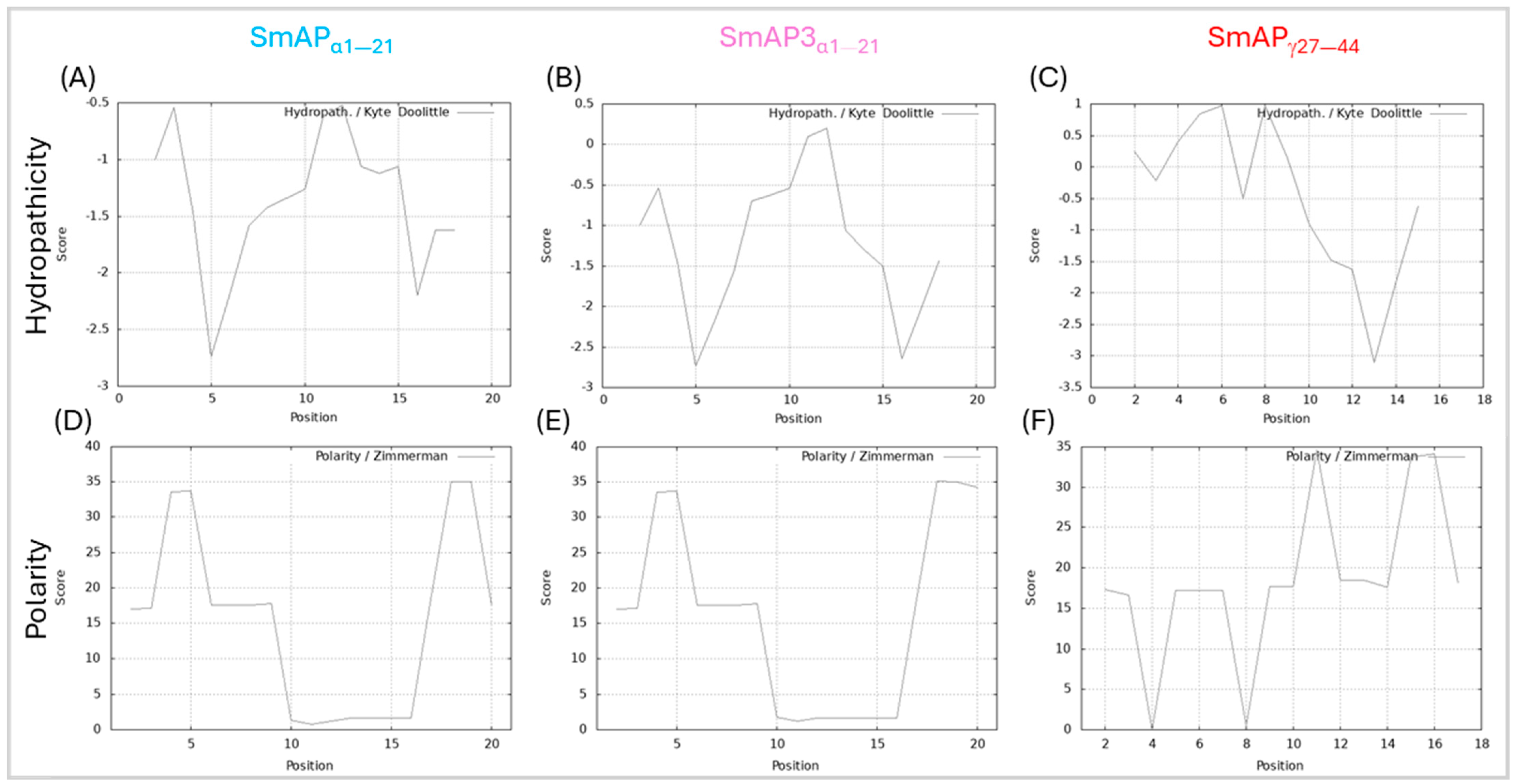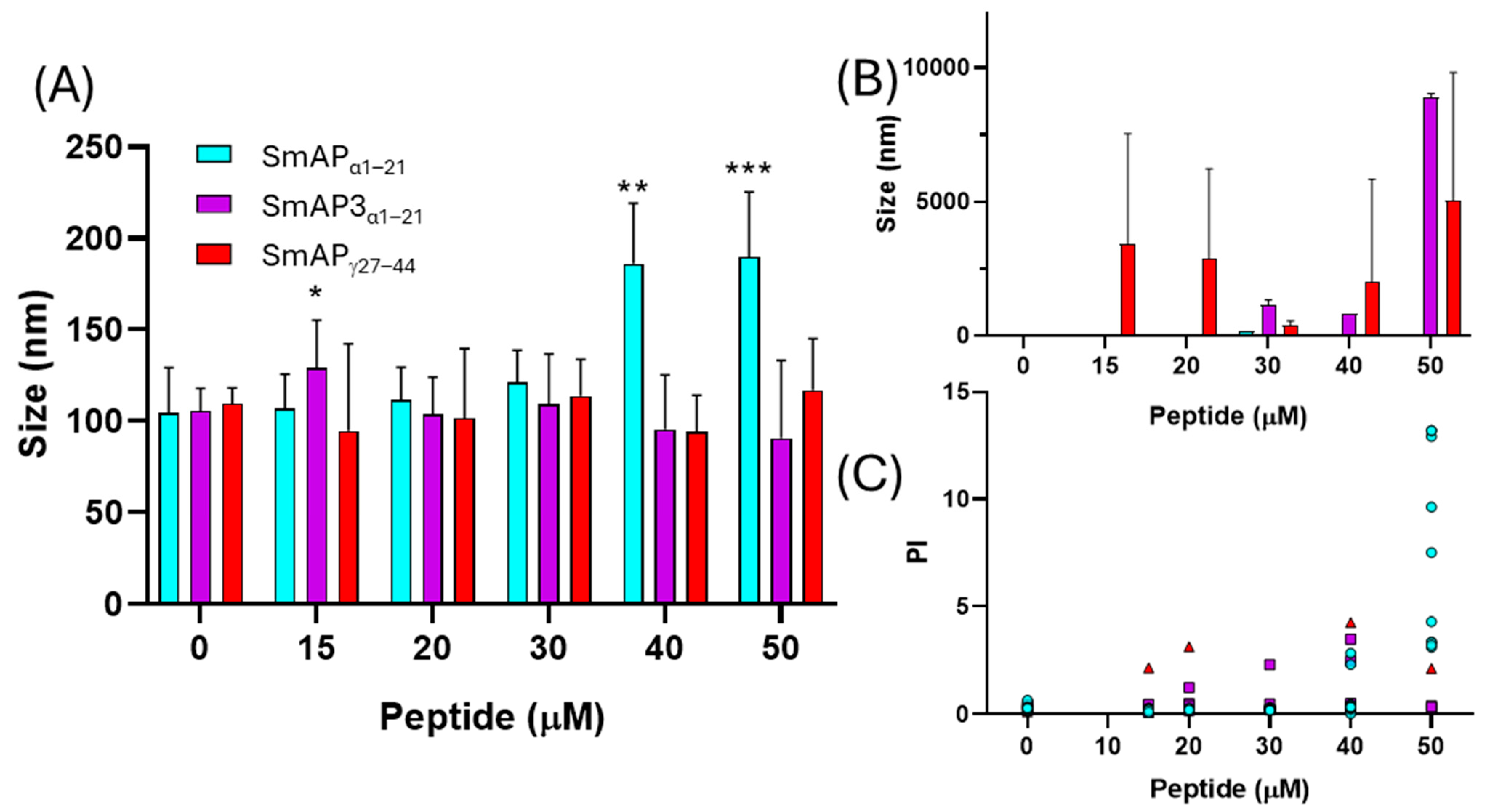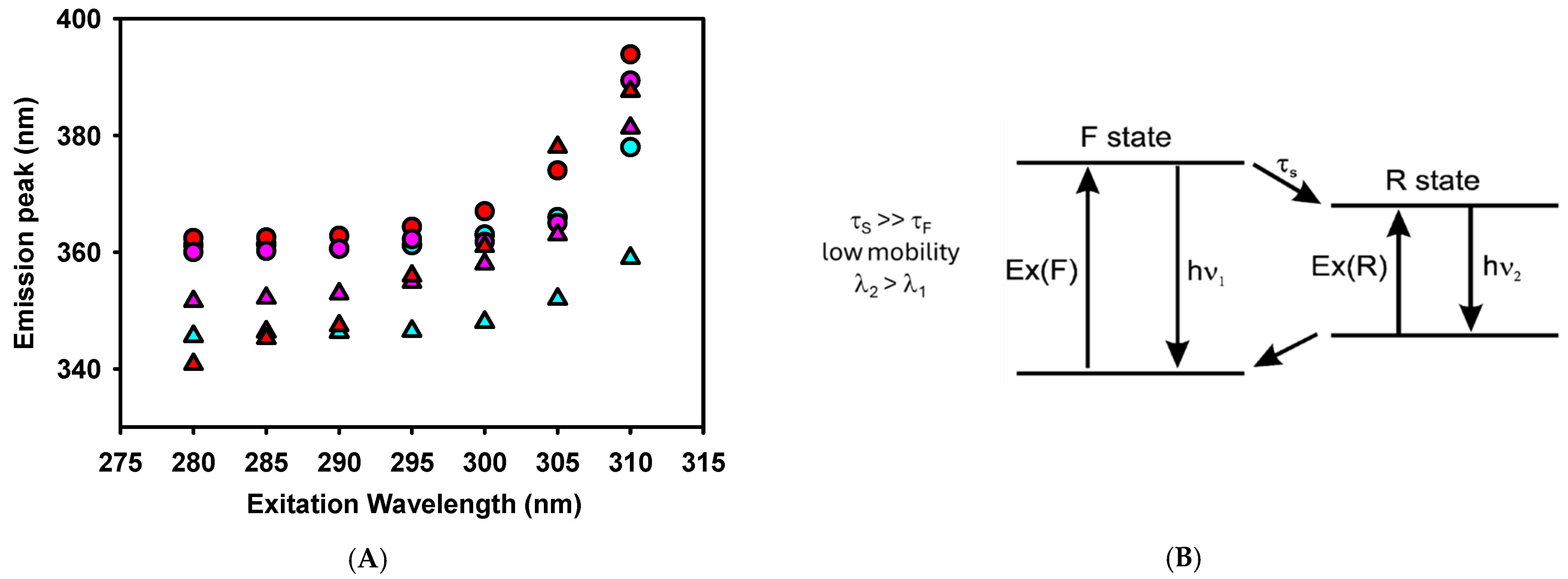Antifungal Peptides SmAPα1–21 and SmAPγ27–44 Designed from Different Loops of DefSm2-D Have Distinct Modes of Action
Abstract
:1. Introduction
2. Results
2.1. Peptides Characterization
2.2. Peptides—Vesicle Interaction Induces Membrane Remodeling
2.3. Peptides—Model Membrane Interaction Assessed by Tryptophan Fluorescence
2.4. Interaction of Peptides with F. graminearum Macroconidia
3. Discussion
4. Materials and Methods
4.1. Peptide Design and Synthesis
4.2. Antifungal Activity
4.3. Model Lipid Membrane
4.4. Liposome Preparation
4.5. Particle Analysis
4.6. Red Edge Excitation Shift (REES) Experiments
4.7. SmAPγ27–44 Derivatization
4.8. Analysis by Confocal Laser Scanning Microscopy (CLSM) and Subcellular Localization
5. Conclusions
Supplementary Materials
Author Contributions
Funding
Institutional Review Board Statement
Informed Consent Statement
Data Availability Statement
Acknowledgments
Conflicts of Interest
References
- de Chaves, M.A.; Reginatto, P.; da Costa, B.S.; de Paschoal, R.I.; Teixeira, M.L.; Fuentefria, A.M. Fungicide Resistance in Fusarium graminearum Species Complex. Curr. Microbiol. 2022, 79, 62. [Google Scholar] [CrossRef] [PubMed]
- WHO. WHO Fungal Priority Pathogens List to Guide Research, Development and Public Health Action; WHO: Geneva, Switzerland, 2022; Available online: https://www.who.int/publications/i/item/9789240060241 (accessed on 12 December 2024).
- FAO. Resistencia a los Antimicrobianos. Available online: https://www.fao.org/fao-who-codexalimentarius/themes/antimicrobial-resistance/es/ (accessed on 12 March 2023).
- Slezina, M.P.; Istomina, E.A.; Kulakovskaya, E.V.; Korostyleva, T.V.; Odintsova, T.I. The γ-Core Motif Peptides of AMPs from Grasses Display Inhibitory Activity against Human and Plant Pathogens. Int. J. Mol. Sci. 2022, 23, 8383. [Google Scholar] [CrossRef] [PubMed]
- Silva, M.S.; Arraes, F.B.M.; Campos, M.D.A.; Grossi-de-Sa, M.; Fernandez, D.; Cândido, E.D.S.; Cardoso, M.H.; Franco, O.L.; Grossi-de-Sa, M.F. Potential Biotechnological Assets Related to Plant Immunity Modulation Applicable in Engineering Disease-Resistant Crops. Plant Sci. 2018, 270, 72–84. [Google Scholar] [CrossRef]
- van der Weerden, N.L.; Parisi, K.; McKenna, J.A.; Hayes, B.M.; Harvey, P.J.; Quimbar, P.; Wevrett, S.R.; Veneer, P.K.; McCorkelle, O.; Vasa, S.; et al. The Plant Defensin Ppdef1 Is a Novel Topical Treatment for Onychomycosis. J. Fungi 2023, 9, 1111. [Google Scholar] [CrossRef]
- Li, H.; Kalunke, R.; Tetorya, M.; Czymmek, K.J.; Shah, D.M. Modes of Action and Potential as a Peptide-based Biofungicide of a Plant Defensin MtDef4. Mol. Plant Pathol. 2024, 25, e13458. [Google Scholar] [CrossRef]
- Thery, T.; Lynch, K.M.; Arendt, E.K. Natural Antifungal Peptides/Proteins as Model for Novel Food Preservatives. Compr. Rev. Food Sci. Food Saf. 2019, 18, 1327–1360. [Google Scholar] [CrossRef]
- da Cunha, N.B.; Cobacho, N.B.; Viana, J.F.C.; Lima, L.A.; Sampaio, K.B.O.; Dohms, S.S.M.; Ferreira, A.C.R.; de la Fuente-Núñez, C.; Costa, F.F.; Franco, O.L.; et al. The next Generation of Antimicrobial Peptides (AMPs) as Molecular Therapeutic Tools for the Treatment of Diseases with Social and Economic Impacts. Drug Discov. Today 2017, 22, 234–248. [Google Scholar] [CrossRef]
- Li, S.; Wang, Y.; Xue, Z.; Jia, Y.; Li, R.; He, C.; Chen, H. The Structure-Mechanism Relationship and Mode of Actions of Antimicrobial Peptides: A Review. Trends Food Sci. Technol. 2021, 109, 103–115. [Google Scholar] [CrossRef]
- Giner-Llorca, M.; Gallego del Sol, F.; Marcos, J.F.; Marina, A.; Manzanares, P. Rationally Designed Antifungal Protein Chimeras Reveal New Insights into Structure-Activity Relationship. Int. J. Biol. Macromol. 2022, 225, 135–148. [Google Scholar] [CrossRef]
- Graham, M.A.; Silverstein, K.A.T.; VandenBosch, K.A. Defensin-like Genes: Genomic Perspectives on a Diverse Superfamily in Plants. Crop Sci. 2008, 48, S-3–S-11. [Google Scholar] [CrossRef]
- Giacomelli, L.; Nanni, V.; Lenzi, L.; Zhuang, J.; Serra, M.D.; Banfield, M.J.; Town, C.D.; Silverstein, K.A.T.; Baraldi, E.; Moser, C. Identification and Characterization of the Defensin-like Gene Family of Grapevine. Mol. Plant-Microbe Interact. 2012, 25, 1118–1131. [Google Scholar] [CrossRef] [PubMed]
- Fernández, A.; Colombo, M.L.; Curto, L.M.; Gómez, G.E.; Delfino, J.M.; Guzmán, F.; Bakás, L.; Malbrán, I.; Vairo Cavalli, S. Peptides Derived From the α -Core and γ -Core Regions of a Putative Silybum marianum Flower Defensin Show Antifungal Activity Against Fusarium Graminearum. Front. Microbiol. 2021, 12, 632008. [Google Scholar] [CrossRef] [PubMed]
- Parisi, K.; McKenna, J.A.; Lowe, R.; Harris, K.S.; Shafee, T.; Guarino, R.; Lee, E.; van der Weerden, N.L.; Bleackley, M.R.; Anderson, M.A. Hyperpolarisation of Mitochondrial Membranes Is a Critical Component of the Antifungal Mechanism of the Plant Defensin, Ppdef1. J. Fungi 2024, 10, 54. [Google Scholar] [CrossRef] [PubMed]
- El-Mounadi, K.; Islam, K.T.; Hernández-Ortiz, P.; Read, N.D.; Shah, D.M. Antifungal Mechanisms of a Plant Defensin MtDef4 Are Not Conserved between the Ascomycete Fungi Neurospora crassa and Fusarium graminearum. Mol. Microbiol. 2016, 100, 542–559. [Google Scholar] [CrossRef]
- Tetorya, M.; Li, H.; Djami-Tchatchou, A.T.; Buchko, G.W.; Czymmek, K.J.; Shah, D.M. Plant Defensin MtDef4-derived Antifungal Peptide with Multiple Modes of Action and Potential as a Bio-inspired Fungicide. Mol. Plant Pathol. 2023, 24, 893–913. [Google Scholar] [CrossRef]
- Yeaman, M.R.; Yount, N.Y. Unifying Themes in Host Defence Effector Polypeptides. Nat. Rev. 2007, 5, 727–740. [Google Scholar] [CrossRef]
- Slezina, M.P.; Istomina, E.A.; Korostyleva, T.V.; Odintsova, T.I. The γ-Core Motif Peptides of Plant AMPs as Novel Antimicrobials for Medicine and Agriculture. Int. J. Mol. Sci. 2023, 24, 483. [Google Scholar] [CrossRef]
- Sathoff, A.E.; Velivelli, S.; Shah, D.M.; Samac, D.A. Plant Defensin Peptides Have Antifungal and Antibacterial Activity against Human and Plant Pathogens. Phytopathology 2019, 109, 402–408. [Google Scholar] [CrossRef]
- Fernández, A.; González, M.; Malbrán, I.; Vázquez, R.F.; Maté, S.M.; Guzmán, F.; Bakás, L.S.; Vairo Cavalli, S. Histidine 19 Residue Is Essential for Cell Internalization of Antifungal Peptide SmAPα1-21 Derived from the α-Core of the Silybum Marianum Defensin DefSm2-D in Fusarium Graminearum. Antibiotics 2022, 11, 1501. [Google Scholar] [CrossRef]
- Lentini, F.; Venza, F. Wild Food Plants of Popular Use in Sicily. J. Ethnobiol. Ethnomed. 2007, 3, 15. [Google Scholar] [CrossRef]
- Tardio, J.; Pardo-de-Santayana, M.; Morales, R. Ethnobotanical Review of Wild Edible Plants in Spain. Bot. J. Linn. Soc. 2006, 152, 27–71. [Google Scholar] [CrossRef]
- Thevissen, K.; François, I.E.J.A.; Takemoto, J.Y.; Ferket, K.K.A.; Meert, E.M.K.; Cammue, B.P.A. DmAMP1, an Antifungal Plant Defensin from Dahlia (Dahlia Merckii), Interacts with Sphingolipids from Saccharomyces cerevisiae. FEMS Microbiol. Lett. 2003, 226, 169–173. [Google Scholar] [CrossRef] [PubMed]
- De Zélicourt, A.; Letousey, P.; Thoiron, S.; Campion, C.; Simoneau, P.; Elmorjani, K.; Marion, D.; Simier, P.; Delavault, P. Ha-DEF1, a Sunflower Defensin, Induces Cell Death in Orobanche Parasitic Plants. Planta 2007, 226, 591–600. [Google Scholar] [CrossRef] [PubMed]
- Kufareva, I.; Abagyan, R. Methods of Protein Structure Comparison. In Homology Modeling: Methods and Protocols; Humana Press: Totowa, NJ, USA, 2012; pp. 231–257. [Google Scholar]
- de las Mercedes Zulueta Díaz, Y. Regulación de La Interacción de Anfifilos Con Membranas Lipídicas Modelo. Ph.D. Thesis, Universidad Nacional de Córdoba, Córdoba, Argentina, 2019. [Google Scholar]
- Suárez-Germà, C.; Montero, M.T.; Ignés-Mullol, J.; Hernández-Borrell, J.; Domènech, Ò. Acyl Chain Differences in Phosphatidylethanolamine Determine Domain Formation and LacY Distribution in Biomimetic Model Membranes. J. Phys. Chem. B 2011, 115, 12778–12784. [Google Scholar] [CrossRef]
- Mangiarotti, A.; Galassi, V.V.; Puentes, E.N.; Oliveira, R.G.; Del Pópolo, M.G.; Wilke, N. Hopanoids like Sterols Form Compact but Fluid Films. Langmuir 2019, 35, 9848–9857. [Google Scholar] [CrossRef]
- Yoon, J.H.; Lee, K.S.; Yang, J.E.; Won, M.S.; Shim, Y.B. Electron Transfer Kinetics and Morphology of Cytochrome c at the Biomimetic Phospholipid Layers. J. Electroanal. Chem. 2010, 644, 36–43. [Google Scholar] [CrossRef]
- Bhattacharjee, S. DLS and Zeta Potential—What They Are and What They Are Not? J. Control. Release 2016, 235, 337–351. [Google Scholar] [CrossRef]
- Hollmann, A.; Martinez, M.; Maturana, P.; Semorile, L.C.; Maffia, P.C. Antimicrobial Peptides: Interaction with Model and Biological Membranes and Synergism with Chemical Antibiotics. Front. Chem. 2018, 6, 1–13. [Google Scholar] [CrossRef]
- Michalek, M.; Aisenbrey, C.; Bechinger, B. Investigation of Membrane Penetration Depth and Interactions of the Amino-Terminal Domain of Huntingtin: Refined Analysis by Tryptophan Fluorescence Measurement. Eur. Biophys. J. 2014, 43, 347–360. [Google Scholar] [CrossRef]
- Tory, M.C.; Rod Merrill, A. Determination of Membrane Protein Topology by Red-Edge Excitation Shift Analysis: Application to the Membrane-Bound Colicin E1 Channel Peptide. Biochim. Biophys. Acta BBA—Biomembr. 2002, 1564, 435–448. [Google Scholar] [CrossRef]
- Lakowicz, J.R. Principles of Fluorescence Spectroscopy; Springer: Boston, MA, USA, 2006; ISBN 978-0-387-31278-1/978-0-387-46312-4. [Google Scholar]
- Alvares, D.S.; Wilke, N.; Ruggiero Neto, J. Effect of N-Terminal Acetylation on Lytic Activity and Lipid-Packing Perturbation Induced in Model Membranes by a Mastoparan-like Peptide. Biochim. Biophys. Acta BBA—Biomembr. 2018, 1860, 737–748. [Google Scholar] [CrossRef] [PubMed]
- Lichius, A.; Zeilinger, S. Application of Membrane and Cell Wall Selective Fluorescent Dyes for Live-Cell Imaging of Filamentous Fungi. J. Vis. Exp. 2019, 2019, 1–16. [Google Scholar] [CrossRef]
- Odintsova, T.I.; Slezina, M.P.; Istomina, E.A. Defensins of Grasses: A Systematic Review. Biomolecules 2020, 10, 1029. [Google Scholar] [CrossRef]
- Terras, F.; Schoofs, H.; De Bolle, M.; Van Leuven, F.; Rees, S.B.; Vanderleyden, J.; Cammue, B.; Broekaert, W. Analysis of Two Novel Classes of Plant Antifungal Proteins from Radish (Raphanus Sativus L.) Seeds. J. Biol. Chem. 1992, 267, 15301–15309. [Google Scholar] [CrossRef]
- Struyfs, C.; Cammue, B.P.A.; Thevissen, K. Membrane-Interacting Antifungal Peptides. Front. Cell Dev. Biol. 2021, 9, 649875. [Google Scholar] [CrossRef]
- Li, H.; Velivelli, S.L.S.; Shah, D.M. Antifungal Potency and Modes of Action of a Novel Olive Tree Defensin Against Closely Related Ascomycete Fungal Pathogens. Mol. Plant-Microbe Interact. 2019, 32, 1649–1664. [Google Scholar] [CrossRef]
- Cools, T.L.; Struyfs, C.; Cammue, B.P.; Thevissen, K. Antifungal Plant Defensins: Increased Insight in Their Mode of Action as a Basis for Their Use to Combat Fungal Infections. Future Microbiol. 2017, 12, 441–454. [Google Scholar] [CrossRef]
- Lee, J.; Hwang, J.S.; Hwang, B.; Kim, J.K.; Kim, S.R.; Kim, Y.; Lee, D.G. Influence of the Papiliocin Peptide Derived from Papilio Xuthus on the Perturbation of Fungal Cell Membranes. FEMS Microbiol. Lett. 2010, 311, 70–75. [Google Scholar] [CrossRef]
- Kvansakul, M.; Lay, F.T.; Adda, C.G.; Veneer, P.K.; Baxter, A.A.; Phan, T.K.; Poon, I.K.H.; Hulett, M.D. Binding of Phosphatidic Acid by NsD7 Mediates the Formation of Helical Defensin-Lipid Oligomeric Assemblies and Membrane Permeabilization. Proc. Natl. Acad. Sci. USA 2016, 113, 11202–11207. [Google Scholar] [CrossRef]
- Sagaram, U.S.; El-Mounadi, K.; Buchko, G.W.; Berg, H.R.; Kaur, J.; Pandurangi, R.S.; Smith, T.J.; Shah, D.M. Structural and Functional Studies of a Phosphatidic Acid-Binding Antifungal Plant Defensin MtDef4: Identification of an RGFRRR Motif Governing Fungal Cell Entry. PLoS ONE 2013, 8, e82485. [Google Scholar] [CrossRef]
- Cools, T.L.; Vriens, K.; Struyfs, C.; Verbandt, S.; Ramada, M.H.S.; Brand, G.D.; Bloch, C.; Koch, B.; Traven, A.; Drijfhout, J.W.; et al. The Antifungal Plant Defensin HsAFP1 Is a Phosphatidic Acid-Interacting Peptide Inducing Membrane Permeabilization. Front. Microbiol. 2017, 8, 2295. [Google Scholar] [CrossRef] [PubMed]
- Benedini, L.; Antollini, S.; Fanani, M.L.; Palma, S.; Messina, P.; Schulz, P. Study of the Influence of Ascorbyl Palmitate and Amiodarone in the Stability of Unilamellar Liposomes. Mol. Membr. Biol. 2014, 31, 85–94. [Google Scholar] [CrossRef] [PubMed]
- Kyte, J.; Doolittle, R.F. A Simple Method for Displaying the Hydropathic Character of a Protein. J. Mol. Biol. 1982, 157, 105–132. [Google Scholar] [CrossRef] [PubMed]
- Maturana, P.; Martinez, M.; Noguera, M.E.; Santos, N.C.; Disalvo, E.A.; Semorile, L.; Maffia, P.C.; Hollmann, A. Lipid Selectivity in Novel Antimicrobial Peptides: Implication on Antimicrobial and Hemolytic Activity. Colloids Surf. B Biointerfaces 2017, 153, 152–159. [Google Scholar] [CrossRef]
- Choi, Y.; David, A. Cell Penetrating Peptides and the Mechanisms for Intracellular Entry. Curr. Pharm. Biotechnol. 2014, 15, 192–199. [Google Scholar] [CrossRef]
- Crosio, M.A.; Via, M.A.; Cámara, C.I.; Mangiarotti, A.; Del Pópolo, M.G.; Wilke, N. Interaction of a Polyarginine Peptide with Membranes of Different Mechanical Properties. Biomolecules 2019, 9, 625. [Google Scholar] [CrossRef]
- Falls, L.A.; Furie, B.C.; Jacobs, M.; Furie, B.; Rigby, A.C. The ω-Loop Region of the Human Prothrombin γ-Carboxyglutamic Acid Domain Penetrates Anionic Phospholipid Membranes. J. Biol. Chem. 2001, 276, 23895–23902. [Google Scholar] [CrossRef]
- Via, M.A.; Klug, J.; Wilke, N.; Mayorga, L.S.; Del Pópolo, M.G. The Interfacial Electrostatic Potential Modulates the Insertion of Cell-Penetrating Peptides into Lipid Bilayers. Phys. Chem. Chem. Phys. 2018, 20, 5180–5189. [Google Scholar] [CrossRef]
- Luna, O.F.; Gomez, J.; Cárdenas, C.; Albericio, F.; Marshall, S.H.; Guzmán, F. Deprotection Reagents in Fmoc Solid Phase Peptide Synthesis: Moving Away from Piperidine? Molecules 2016, 21, 1542. [Google Scholar] [CrossRef]
- Niedermeyer, T.H.J.; Strohalm, M. MMass as a Software Tool for the Annotation of Cyclic Peptide Tandem Mass Spectra. PLoS ONE 2012, 7, e44913. [Google Scholar] [CrossRef]
- Strohalm, M.; Hassman, M.; Košata, B.; Kodíček, M. MMass Data Miner: An Open Source Alternative for Mass Spectrometric Data Analysis. Rapid Commun. Mass Spectrom. 2008, 22, 905–908. [Google Scholar] [CrossRef]
- Gasteiger, E.; Gattiker, A.; Hoogland, C.; Ivanyi, I.; Appel, R.D.; Bairoch, A. ExPASy: The Proteomics Server for in-Depth Protein Knowledge and Analysis. Nucleic Acids Res. 2003, 31, 3784–3788. [Google Scholar] [CrossRef] [PubMed]
- Mirdita, M.; Schütze, K.; Moriwaki, Y.; Heo, L.; Ovchinnikov, S.; Steinegger, M. ColabFold: Making Protein Folding Accessible to All. Nat. Methods 2022, 19, 679–682. [Google Scholar] [CrossRef] [PubMed]
- Pettersen, E.F.; Goddard, T.D.; Huang, C.C.; Couch, G.S.; Greenblatt, D.M.; Meng, E.C.; Ferrin, T.E. UCSF Chimera—A Visualization System for Exploratory Research and Analysis. J. Comput. Chem. 2004, 25, 1605–1612. [Google Scholar] [CrossRef]
- Meng, E.C.; Pettersen, E.F.; Couch, G.S.; Huang, C.C.; Ferrin, T.E. Tools for integrated sequence-structure analysis with UCSF Chimera. BMC Bioinform. 2006, 7, 339. [Google Scholar] [CrossRef]
- Zulueta Díaz, Y.D.L.M.; Caby, S.; Bongarzone, E.R.; Fanani, M.L. Psychosine Remodels Model Lipid Membranes at Neutral PH. Biochim. Biophys. Acta BBA—Biomembr. 2018, 1860, 2515–2526. [Google Scholar] [CrossRef]
- Giudice, F.; Ambroggio, E.E.; Mottola, M.; Fanani, M.L. The Amphiphilic Alkyl Ester Derivatives of l -Ascorbic Acid Induce Reorganization of Phospholipid Vesicles. Biochim. Biophys. Acta BBA—Biomembr. 2016, 1858, 2132–2139. [Google Scholar] [CrossRef] [PubMed]








| Peptide Name | Sequence | Molecular Weight 1 (Da) | pI 2 | Net Charge 3 | GRAVY Value 4 | MIC (μM) 5 | Time to Kill (min) |
|---|---|---|---|---|---|---|---|
| SmAPγ27–44 | WEGAVHGACHVRNGKHMC | 1991.5 | 8.1 * | 3.8 * | −0.938 | 20 * | 30 * |
| SmAPα1–21 | KLCEKPSKTWFGNCGNPRHCG | 2361.6 | 9.0 * | 4 * | −1.076 | 32 * | 60–180 * |
| SmAP3α1–21 | KLCEKPSKTWSGNCGNTHHCD | 2348.1 | 8.0 | 2.8 | −1.290 | >100 | nd |
| Peptide | Emission Peak Shift (Ex 280 nm) | REES Peptide (nm) | REES Peptide + LUVs (nm) |
|---|---|---|---|
| SmAPγ27–44 | 17 ± 6 | 26 ± 5 | 38 ± 2 |
| SmAPα1–21 | 14 ± 3 | 17 ± 2 | 11 ± 3 |
| SmAP3α1–21 | 7 ± 2 | 28 ± 4 | 28 ± 3 |
Disclaimer/Publisher’s Note: The statements, opinions and data contained in all publications are solely those of the individual author(s) and contributor(s) and not of MDPI and/or the editor(s). MDPI and/or the editor(s) disclaim responsibility for any injury to people or property resulting from any ideas, methods, instructions or products referred to in the content. |
© 2025 by the authors. Licensee MDPI, Basel, Switzerland. This article is an open access article distributed under the terms and conditions of the Creative Commons Attribution (CC BY) license (https://creativecommons.org/licenses/by/4.0/).
Share and Cite
Iturralde, M.; Bracho, J.P.; Valdivia-Pérez, J.A.; Guzmán, F.; Malbrán, I.; Maté, S.M.; Fanani, M.L.; Vairo Cavalli, S. Antifungal Peptides SmAPα1–21 and SmAPγ27–44 Designed from Different Loops of DefSm2-D Have Distinct Modes of Action. Antibiotics 2025, 14, 430. https://doi.org/10.3390/antibiotics14050430
Iturralde M, Bracho JP, Valdivia-Pérez JA, Guzmán F, Malbrán I, Maté SM, Fanani ML, Vairo Cavalli S. Antifungal Peptides SmAPα1–21 and SmAPγ27–44 Designed from Different Loops of DefSm2-D Have Distinct Modes of Action. Antibiotics. 2025; 14(5):430. https://doi.org/10.3390/antibiotics14050430
Chicago/Turabian StyleIturralde, Micaela, Juan Pablo Bracho, Jessica A. Valdivia-Pérez, Fanny Guzmán, Ismael Malbrán, Sabina María Maté, María Laura Fanani, and Sandra Vairo Cavalli. 2025. "Antifungal Peptides SmAPα1–21 and SmAPγ27–44 Designed from Different Loops of DefSm2-D Have Distinct Modes of Action" Antibiotics 14, no. 5: 430. https://doi.org/10.3390/antibiotics14050430
APA StyleIturralde, M., Bracho, J. P., Valdivia-Pérez, J. A., Guzmán, F., Malbrán, I., Maté, S. M., Fanani, M. L., & Vairo Cavalli, S. (2025). Antifungal Peptides SmAPα1–21 and SmAPγ27–44 Designed from Different Loops of DefSm2-D Have Distinct Modes of Action. Antibiotics, 14(5), 430. https://doi.org/10.3390/antibiotics14050430








